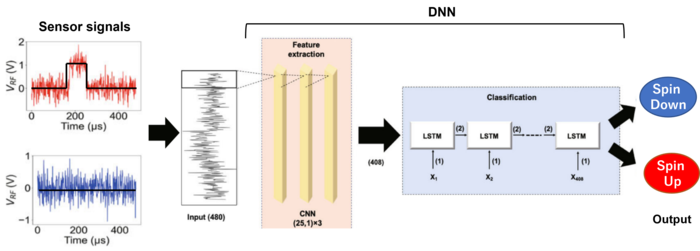At the Institute of Scientific and Industrial Research (SANKEN) of Osaka University, scientists have trained a deep neural network to accurately identify the output state of quantum bits, even in the presence of environmental noise.
 Architecture of the DNN classifier. Image Credit: Yuta Matsumoto et al.
Architecture of the DNN classifier. Image Credit: Yuta Matsumoto et al.
The innovative technique used by the researchers might enable the wider usage of quantum computers.
Modern computers are based on binary logic, where each bit is either a 1 or a 0. However, the unique rules of quantum mechanics have allowed new experimental systems to achieve higher computing power by enabling quantum bits, also known as qubits, to be in “superpositions” of 1 and 0.
For instance, the spins of electrons restricted to small islands known as quantum dots can be oriented both upward and downward at the same time. But when a bit’s final state is read out, it returns back to the classical behavior of being in one orientation or the other.
Rendering quantum computing adequately reliable for consumer use would necessitate the creation of new systems that can precisely record each qubit’s output even when a lot of noise occurs in the signal.
A research group headed by SANKEN recently used a machine learning method known as a deep neural network to detect the signal produced by the spin orientation of electrons on quantum dots.
We developed a classifier based on deep neural network to precisely measure a qubit state even with noisy signals.
Takafumi Fujita, Study Co-Author, Institute of Scientific and Industrial Research, Osaka University
The experimental system is designed such that only electrons exhibiting a specific spin orientation can leave a quantum dot. This phenomenon leads to the generation of a temporary “blip” of increased voltage. The researchers trained the machine learning algorithm to detect these signals from the noise.
The deep neural network used by the researchers included a convolutional neural network to determine the significant signal features, together with a recurrent neural network to track the time-series data.
Our approach simplified the learning process for adapting to strong interference that could vary based on the situation.
Akira Oiwa, Study Senior Author, Institute of Scientific and Industrial Research, Osaka University
Initially, the researchers tested the durability of the classifier by adding simulated noise and drift. The algorithm was then trained to work with actual data from an array of quantum dots, realizing accuracy rates of more than 95%. The study findings might enable high-fidelity measurement of large-scale qubit arrays in future quantum computers.
Journal Reference:
Matsumoto, Y., et al. (2021) Noise-robust classification of single-shot electron spin readouts using a deep neural network. npj Quantum Information. doi.org/10.1038/s41534-021-00470-7.